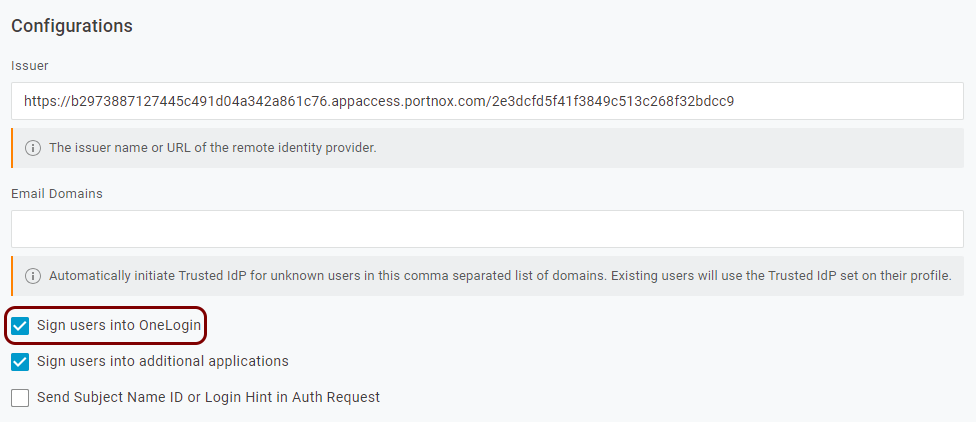Integrate OneLogin with Conditional Access
In this topic, you will find general instructions on how to integrate OneLogin with Portnox™ Conditional Access for Applications.
Create a Portnox Cloud application configuration
In this step, you will create a configuration in Portnox Cloud that will contain all the information necessary to integrate with OneLogin.
-
In a new tab of your browser, open your Portnox Cloud account by accessing the following URL: https://clear.portnox.com/
From now on, we will call this tab the Portnox tab.
-
In the Cloud portal top menu, click on the Applications option.

-
On the APPLICATIONS screen, click on the Add new SAML application
button.

- Optional: If you have more than one SAML identity provider configured, select the identity provider in the Select an identity provider to use for this application section.
-
In the Application details section, enter an Application
name and optionally a Description.

In this example, we used the name OneLogin for the new application configuration but you can use any name you like.
- Keep this browser tab open. You will need it later.
Open your OneLogin trusted IdPs settings
In this section, you will access your OneLogin dashboard and find the settings for trusted identity providers (IdPs).
-
In another tab of your browser, open your OneLogin Trusted IdPs page by accessing the
following URL: https://your_tenant.onelogin.com/trusted_idps/, where
your_tenant is your tenant name.
From now on, we will call this tab the OneLogin tab.
-
Click on the New Trust button in the top-right corner.

-
In the Trusted IdPs field in the top-left corner, enter a name for this identity provider,
and then click on the ✓ icon.

In this example, we used the name Portnox Conditional Access but you can use any name you like.
Copy configuration values from the Portnox tab to the OneLogin tab
In this section, you will copy the values displayed by Portnox Cloud and paste them in the relevant fields in the OneLogin trusted IdP configuration section.
-
In the Portnox tab, in the Service details section, click on the ⧉ icon next to the Identity Provider Entity ID / Audience
URI field to copy the value.

-
In the OneLogin tab, in the Configurations section, click on the empty field under the
Issuer label and paste the value copied from Portnox Cloud.

-
In the Portnox tab, in the Service details section, click on the ⧉ icon next to the Sign-In URL / SSO URL field to copy the
value.

-
In the OneLogin tab, in the SAML Configurations section, click on the empty field under the
IdP Login URL label and paste the value copied from Portnox Cloud.

-
In the Portnox tab, in the Service details section, click on the ⧉ icon next to the Certificate field to copy the
value.

-
In the OneLogin tab, in the Trusted IdP Certificate section, click on the empty field under
the X.509 Certificate label and paste the value copied from Portnox Cloud.

Copy configuration values from the OneLogin tab to the Portnox tab
In this section, you will copy the values displayed in the OneLogin trusted IdP setup section, and paste them in the relevant fields in Portnox Cloud.
-
In the OneLogin tab, in the SAML Configurations section, select the value displayed under
the SP Entity ID label, and use your operating system’s copy shortcut to copy the value to
the clipboard.

-
In the Portnox tab, in the Application properties section, click on the empty field under
the Entity ID / Service Provider Entity URL heading and paste the value copied from
OneLogin.

-
In the Portnox tab, in the Application properties section, click on the empty field under
the Assertion Consumer Service (ACS) URL / Reply URL heading and paste the following value:
https://your_tenant.onelogin.com/access/idp, where
your_tenant is your OneLogin tenant name.

Finalize the configuration
In this section, you will finalize the configuration in Portnox Cloud and OneLogin.
-
Finalize the configuration in the Portnox tab.
-
Finalize the configuration in the OneLogin tab.
Result: You have configured OneLogin to be accessible using Portnox Conditional Access for Applications.








